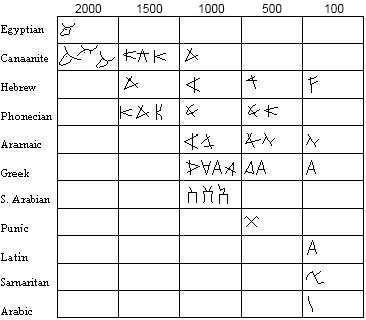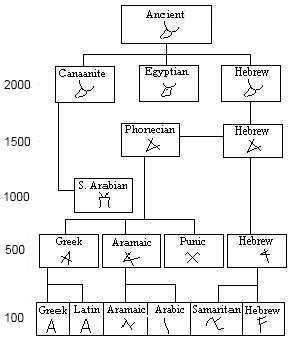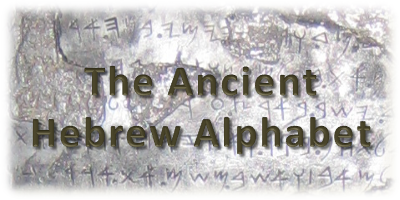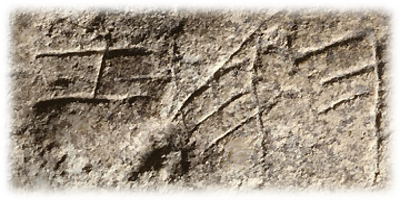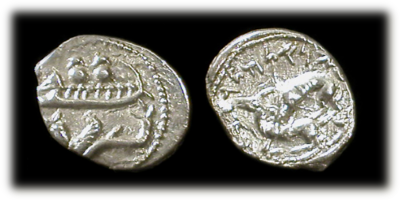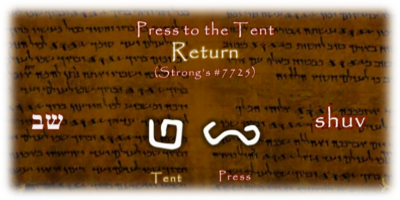Early
Hebrew
|
Middle
Hebrew
|

|

|
Late
Hebrew
|
Modern
Hebrew
|

|

|
|
| Ancient Name: |
Al / El |
| Pictograph: |
Ox Head |
| Meanings: |
Power, Authority, Strength |
| Sound: |
ah, eh |
History & Reconstruction
The original pictograph for this letter is a picture of an ox head ( ) representing strength and power from the work performed by the animal. This pictograph also represents a chief or other leader. When two oxen are yoked together for pulling a wagon or plow, one is the older and more experienced one who leads the other. Within the clan, tribe or family the chief or father is seen as the elder who is yoked to the others as the leader and teacher.
) representing strength and power from the work performed by the animal. This pictograph also represents a chief or other leader. When two oxen are yoked together for pulling a wagon or plow, one is the older and more experienced one who leads the other. Within the clan, tribe or family the chief or father is seen as the elder who is yoked to the others as the leader and teacher.
The Modern name for this letter is aleph and corresponds to the Greek name alpha and the Arabic name aleph. The various meanings of this root are oxen, yoke and learn. Each of these meanings is related to the meanings of the pictograph  . The root (אלף) is an adopted root from the parent root אל (el), written as
. The root (אלף) is an adopted root from the parent root אל (el), written as 
 in the original script, meaning, strength, power and chief and is the probable original name of the pictograph
in the original script, meaning, strength, power and chief and is the probable original name of the pictograph  .
.
The  is a shepherd staff and represents authority as well as a yoke (see the letter lamed). When combined these two pictographs mean "strong authority." The chief or father is the "strong authority." The
is a shepherd staff and represents authority as well as a yoke (see the letter lamed). When combined these two pictographs mean "strong authority." The chief or father is the "strong authority." The 
 can also be understood as the "ox in the yoke." Many Near Eastern cultures worshipped the god El (
can also be understood as the "ox in the yoke." Many Near Eastern cultures worshipped the god El (
 ) and was depicted as a bull in carvings and statues. Israel chose the form of a calf (young bull) as an image of God at Mount Sinai showing their association between the word
) and was depicted as a bull in carvings and statues. Israel chose the form of a calf (young bull) as an image of God at Mount Sinai showing their association between the word 
 and the ox or bull and is also commonly used in the Hebrew Bible for "God" or "god."
and the ox or bull and is also commonly used in the Hebrew Bible for "God" or "god."
The concept of the ox and the shepherd staff in the word 
 has been carried over into modern times as the scepter (as a staff) and crown (as horns) of a monarch, the leader of a nation. These modern items are representative of the shepherd staff, an ancient sign of authority, and the horns of the ox, an ancient sign of strength.
has been carried over into modern times as the scepter (as a staff) and crown (as horns) of a monarch, the leader of a nation. These modern items are representative of the shepherd staff, an ancient sign of authority, and the horns of the ox, an ancient sign of strength.
In Modern Hebrew this letter is silent but was originally used as the vowels "a" and "e." The Greek letter alpha, derived from the aleph, is also used for the "a" sound.
The Early Semitic pictograph  was simplified to
was simplified to  and
and  in the Middle Hebrew script and continued to evolve into the
in the Middle Hebrew script and continued to evolve into the  in the Late Hebrew script. The Modern Hebrew letter א developed out of the Late Semitic. The Middle Semitic was adopted by the Greeks to be the letter "A" (alpha) and carried over into the Roman "A." The Middle Semitic
in the Late Hebrew script. The Modern Hebrew letter א developed out of the Late Semitic. The Middle Semitic was adopted by the Greeks to be the letter "A" (alpha) and carried over into the Roman "A." The Middle Semitic  became the number "1" that we use today.
became the number "1" that we use today.
 ) representing strength and power from the work performed by the animal. This pictograph also represents a chief or other leader. When two oxen are yoked together for pulling a wagon or plow, one is the older and more experienced one who leads the other. Within the clan, tribe or family the chief or father is seen as the elder who is yoked to the others as the leader and teacher.
) representing strength and power from the work performed by the animal. This pictograph also represents a chief or other leader. When two oxen are yoked together for pulling a wagon or plow, one is the older and more experienced one who leads the other. Within the clan, tribe or family the chief or father is seen as the elder who is yoked to the others as the leader and teacher.
 . The root (אלף) is an adopted root from the parent root אל (el), written as
. The root (אלף) is an adopted root from the parent root אל (el), written as 

 .
.
 is a shepherd staff and represents authority as well as a yoke (see the letter lamed). When combined these two pictographs mean "strong authority." The chief or father is the "strong authority." The
is a shepherd staff and represents authority as well as a yoke (see the letter lamed). When combined these two pictographs mean "strong authority." The chief or father is the "strong authority." The 


 )
) 



 was simplified to
was simplified to  and
and  in the Middle Hebrew script and continued to evolve into the
in the Middle Hebrew script and continued to evolve into the  in the Late Hebrew script. The Modern Hebrew letter א developed out of the Late Semitic. The Middle Semitic was adopted by the Greeks to be the letter "A" (alpha) and carried over into the Roman "A." The Middle Semitic
in the Late Hebrew script. The Modern Hebrew letter א developed out of the Late Semitic. The Middle Semitic was adopted by the Greeks to be the letter "A" (alpha) and carried over into the Roman "A." The Middle Semitic  became the number "1" that we use today.
became the number "1" that we use today.
